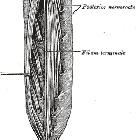Konus-Syndrom


Conus medullaris syndrome is caused by an injury or insult to the conus medullaris and lumbar nerve roots. It is a clinical subset of spinal cord injury syndromes. Injuries at the level of T12 to L2 vertebrae are most likely to result in conus medullaris syndrome.
Clinical presentation
Patients present with a combination of severe back pain and upper and lower motor neuron deficits, similar to cauda equina syndrome, which include :
- saddle anesthesia
- loss of bladder reflex: urinary retention
- loss of bowel reflex: incontinence
- lower limb motor weakness, paresthesia and numbness (mixed upper and lower motor neuron pattern)
Unlike cauda equina syndrome which will only have lower motor neuron deficits, conus medullaris will have a combination of upper and lower motor neuron involvement .
Pathology
The conus medullaris lies in close proximity to nerve roots and injury to this region results in combined upper motor neuron and lower motor neuron features
Conus medullaris injury can result most commonly from:
- lumbar canal stenosis due to herniation of intervertebral disc(s)
- trauma
- vertebral body fractures (e.g. burst fractures)
- traumatic spondylolysis and spondylolisthesis
- tumors
- vertebral body tumors (e.g. vertebral body metastases)
- intrathecal-extramedullary tumors (e.g. spinal meningioma, myxopapillary ependymoma etc... )
- intramedullary tumors (e.g. spinal cord metastases)
- vascular lesions
- infection
Radiographic features
Depending on the suspected etiology in addition to MRI that is almost invariably indicated, CT and catheter angiography may also be required. The features will vary according to the causative pathology and are therefore discussed separately.
Treatment and prognosis
The prognosis depends on upon the timing of patient presentation, the severity of deficits and underlying pathology. Early diagnosis and treatment may facilitate improvement in symptoms. Approximately 10% of patients may regain functional recovery.
Siehe auch:
und weiter:

 Assoziationen und Differentialdiagnosen zu Konus-Syndrom:
Assoziationen und Differentialdiagnosen zu Konus-Syndrom:

